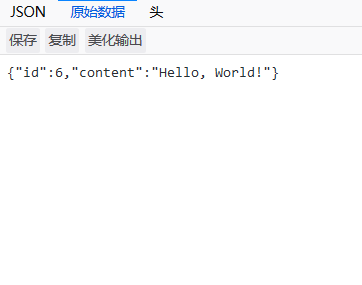RestFul风格是一种非常流行的架构风格,相关实战可以参考我的这篇博客:SSM框架之RestFul示例
论文可参考:https://www.ics.uci.edu/~fielding/pubs/dissertation/top.htm
关于论文,我想说的是,程序员不要对英文产生恐惧感,现在的翻译工具多的多,当然了,多也代表一些杂碎的也不少,所以就需要我们学会如何甄别。
我英语也不好,不过我目前也在学会如何看英文文档,其实英文并没有那么可怕,相反,它还是很有趣的,毕竟我们天天对诸如Eclipse或IDEA这样的英文软件,而且还写着一大堆的英文代码,日子久了,自然都知道是什么意思了。
记得唐代有句古诗:熟读唐诗三百首,不会做诗也会吟。
对于天天敲着英文代码的我们而言,也是如此。每个人都有一个过程,过程周期有长有短。
在这里再闲扯一句,外国人的技术创新能力不容小觑,我们现在用的很多技术,都已经是人家用了好多年甚至已经过时了的,随着经济全球化越来越广越来越深,而且目前国内的培训机构和大学生研究生硕士博士等,如果不想被淘汰,必须要掌握强大学习能力。其中有一项就是英文要会。先不说会不会说,发音标不标准,至少要看的懂是什么意思吧。
总而言之,送我自己和大家一句话,循序渐进。
构建环境为:JDK8+MAVNE3以上+Eclipse
本示例参考Spring官方文档:https://spring.io/guides/gs/rest-service/
一、构建maven依赖
<?xml version="1.0" encoding="UTF-8"?>
<project xmlns="http://maven.apache.org/POM/4.0.0" xmlns:xsi="http://www.w3.org/2001/XMLSchema-instance"
xsi:schemaLocation="http://maven.apache.org/POM/4.0.0 http://maven.apache.org/xsd/maven-4.0.0.xsd">
<modelVersion>4.0.0</modelVersion>
<groupId>org.springframework</groupId>
<artifactId>gs-rest-service</artifactId>
<version>0.1.0</version>
<parent>
<groupId>org.springframework.boot</groupId>
<artifactId>spring-boot-starter-parent</artifactId>
<version>1.5.8.RELEASE</version>
</parent>
<dependencies>
<dependency>
<groupId>org.springframework.boot</groupId>
<artifactId>spring-boot-starter-web</artifactId>
</dependency>
<dependency>
<groupId>org.springframework.boot</groupId>
<artifactId>spring-boot-starter-test</artifactId>
<scope>test</scope>
</dependency>
<dependency>
<groupId>com.jayway.jsonpath</groupId>
<artifactId>json-path</artifactId>
<scope>test</scope>
</dependency>
</dependencies>
<properties>
<java.version>1.8</java.version>
</properties>
<build>
<plugins>
<plugin>
<groupId>org.springframework.boot</groupId>
<artifactId>spring-boot-maven-plugin</artifactId>
</plugin>
</plugins>
</build>
<repositories>
<repository>
<id>spring-releases</id>
<url>https://repo.spring.io/libs-release</url>
</repository>
</repositories>
<pluginRepositories>
<pluginRepository>
<id>spring-releases</id>
<url>https://repo.spring.io/libs-release</url>
</pluginRepository>
</pluginRepositories>
</project>
二、构建实体
package hello;
public class Greeting {
private final long id;
private final String content;
public Greeting(long id, String content) {
this.id = id;
this.content = content;
}
public long getId() {
return id;
}
public String getContent() {
return content;
}
}
三、构建Controller
package hello;
import java.util.concurrent.atomic.AtomicLong;
import org.springframework.web.bind.annotation.RequestMapping;
import org.springframework.web.bind.annotation.RequestParam;
import org.springframework.web.bind.annotation.RestController;
@RestController
public class GreetingController {
private static final String template = "Hello, %s!";
private final AtomicLong counter = new AtomicLong();
@RequestMapping("/greeting")
public Greeting greeting(@RequestParam(value="name", defaultValue="World") String name) {
return new Greeting(counter.incrementAndGet(),
String.format(template, name));
}
}
关于RestController和Controller存在什么不同,主要是RestController中存在一个全局的ResponseBody,从而保证返回的异步数据为JSON数据。
可参考我的博客:前后端交互之封装Ajax+SpringMVC源码分析
另外这里也说说@RequestParam,其实加这个不加这个都可以获取参数,唯一的区别是,如果不加@RequestParm,你必须要确保前台的ajax或者同步请求的参数名必须与后台Controller中对应方法上参数列表中的参数名保持一致,否则会导致参数传输不过来,从而导致某些异常错误信息。
而加了@RequestParam,你可以让前台的值不与后台一致,你只需如下即可:
例如我前台的参数名叫test,我后台加了@RequestParam(value="test") String test001,这样就可以获取对应的参数了。同时的话,我还有可以增加一个叫required的参数,required无论是在input的属性还是后台,都有一个共性叫是否必填。后台中默认是false,不必填,当为true时,为必填。
而前台html中input,加了required,如果不在对应的表单中输入信息,就会提示此表单为必填项诸如此类的信息。
提到@RequestParam时,还不得不提一个叫@PathVariable的注解,这个注解对于经常写博客的友友们非常不陌生,为什么这么说了,比如大家有没有观察到博客园的导航栏
例如:
以我为例
https://home.cnblogs.com/u/youcong/
/u,我想应该是关于用户对应的名称或参数名,而/youcong就是对应的参数值。
这和https://i.cnblogs.com/posts?page=2本质上是一样的,只是参数呈现的表现方式不一样。
从而也凸显@RequestParam和@PathVariable的区别之一。
四、构建启动类
package hello;
import org.springframework.boot.SpringApplication;
import org.springframework.boot.autoconfigure.SpringBootApplication;
@SpringBootApplication
public class Application {
public static void main(String[] args) {
SpringApplication.run(Application.class, args);
}
}
五、执行Application中的main方法即可运行一个SpringBoot的restful风格
最终结果如下图所示:
![]()
另外不得不提下SpringBootApplication的源码:
源码如下:
* Copyright 2012-2017 the original author or authors.
package org.springframework.boot.autoconfigure;
import java.lang.annotation.Documented;
import java.lang.annotation.ElementType;
import java.lang.annotation.Inherited;
import java.lang.annotation.Retention;
import java.lang.annotation.RetentionPolicy;
import java.lang.annotation.Target;
import org.springframework.boot.SpringBootConfiguration;
import org.springframework.boot.context.TypeExcludeFilter;
import org.springframework.context.annotation.Bean;
import org.springframework.context.annotation.ComponentScan;
import org.springframework.context.annotation.ComponentScan.Filter;
import org.springframework.context.annotation.Configuration;
import org.springframework.context.annotation.FilterType;
import org.springframework.core.annotation.AliasFor;
/**
* Indicates a {@link Configuration configuration} class that declares one or more
* {@link Bean @Bean} methods and also triggers {@link EnableAutoConfiguration
* auto-configuration} and {@link ComponentScan component scanning}. This is a convenience
* annotation that is equivalent to declaring {@code @Configuration},
* {@code @EnableAutoConfiguration} and {@code @ComponentScan}.
*
* @author Phillip Webb
* @author Stephane Nicoll
* @since 1.2.0
*/
@Target(ElementType.TYPE)
@Retention(RetentionPolicy.RUNTIME)
@Documented
@Inherited
@SpringBootConfiguration
@EnableAutoConfiguration
@ComponentScan(excludeFilters = {
@Filter(type = FilterType.CUSTOM, classes = TypeExcludeFilter.class),
@Filter(type = FilterType.CUSTOM, classes = AutoConfigurationExcludeFilter.class) })
public @interface SpringBootApplication {
/**
* Exclude specific auto-configuration classes such that they will never be applied.
* @return the classes to exclude
*/
@AliasFor(annotation = EnableAutoConfiguration.class, attribute = "exclude")
Class<?>[] exclude() default {};
/**
* Exclude specific auto-configuration class names such that they will never be
* applied.
* @return the class names to exclude
* @since 1.3.0
*/
@AliasFor(annotation = EnableAutoConfiguration.class, attribute = "excludeName")
String[] excludeName() default {};
/**
* Base packages to scan for annotated components. Use {@link #scanBasePackageClasses}
* for a type-safe alternative to String-based package names.
* @return base packages to scan
* @since 1.3.0
*/
@AliasFor(annotation = ComponentScan.class, attribute = "basePackages")
String[] scanBasePackages() default {};
/**
* Type-safe alternative to {@link #scanBasePackages} for specifying the packages to
* scan for annotated components. The package of each class specified will be scanned.
* <p>
* Consider creating a special no-op marker class or interface in each package that
* serves no purpose other than being referenced by this attribute.
* @return base packages to scan
* @since 1.3.0
*/
@AliasFor(annotation = ComponentScan.class, attribute = "basePackageClasses")
Class<?>[] scanBasePackageClasses() default {};
}
另外也提提@SpringBootApplication的注解包含的意思:
-
@Configuration 标记该类作为应用程序上下文的bean定义的源。
-
@EnableAutoConfiguration 告诉Spring Boot开始根据类路径设置,其他bean和各种属性设置添加bean。
-
通常你会添加@EnableWebMvc一个Spring MVC应用程序,但Spring Boot会在类路径上看到spring-webmvc时自动添加它。这会将应用程序标记为Web应用程序并激活关键行为,例如设置a DispatcherServlet。
-
@ComponentScan告诉Spring在包中寻找其他组件,配置和服务hello,允许它找到控制器。





